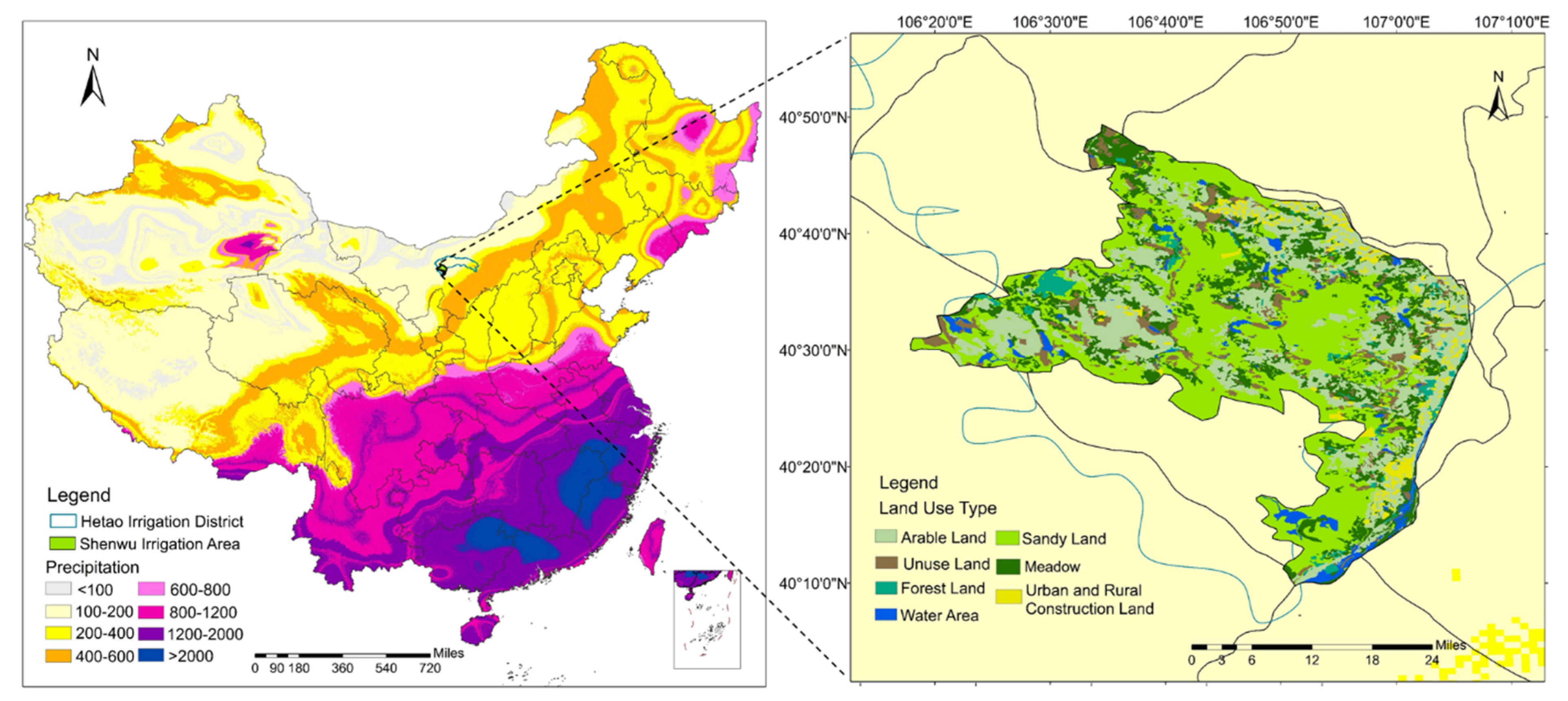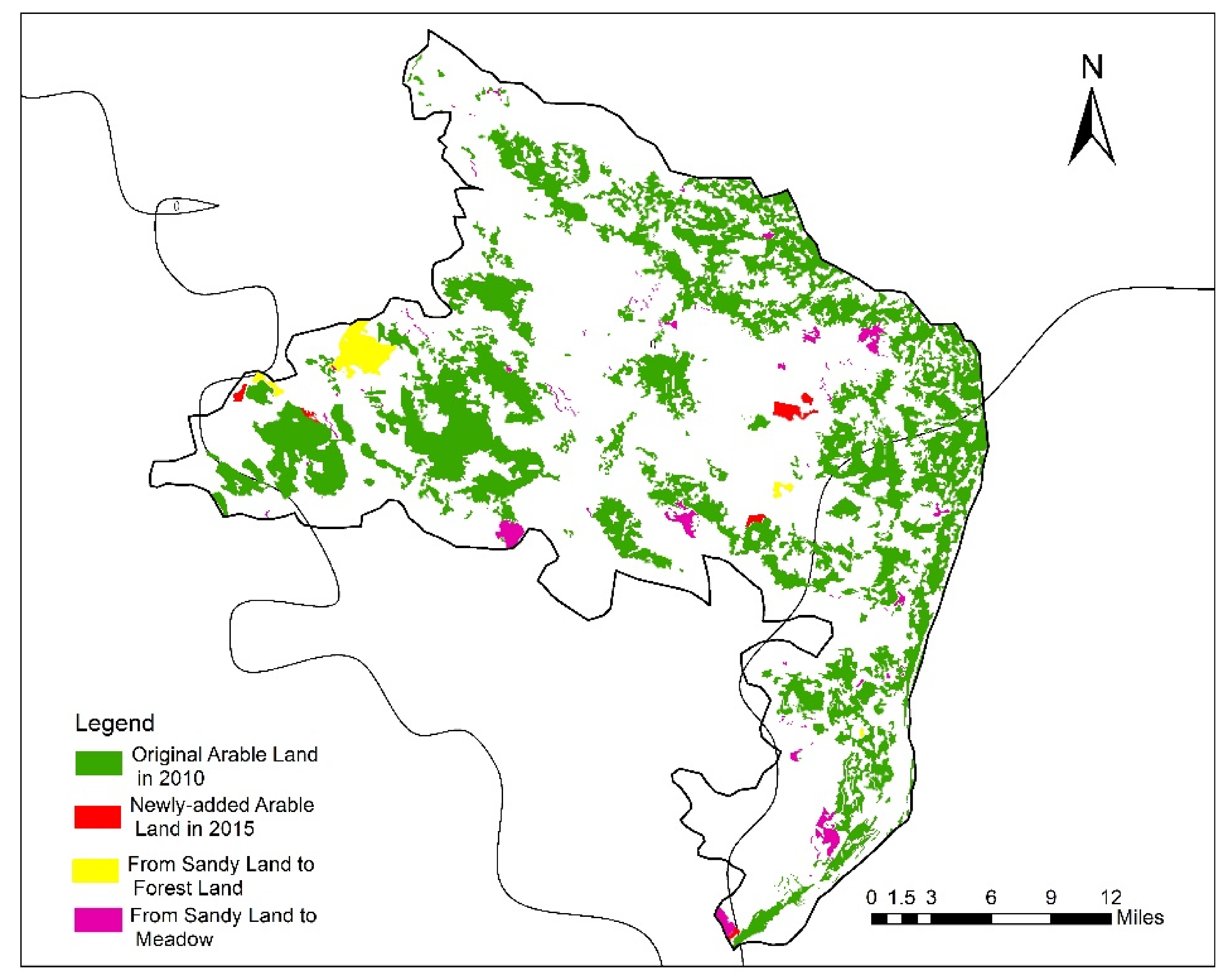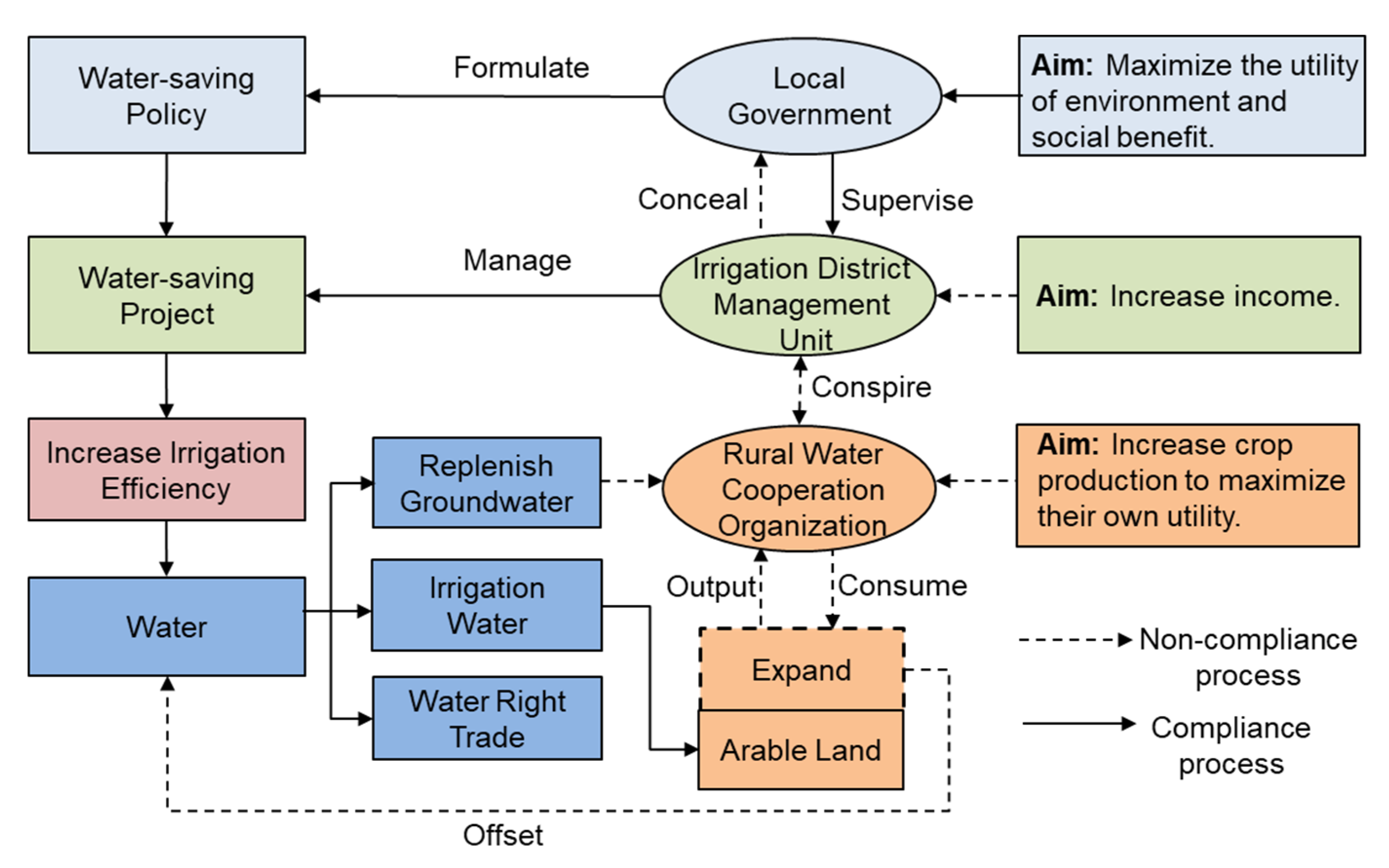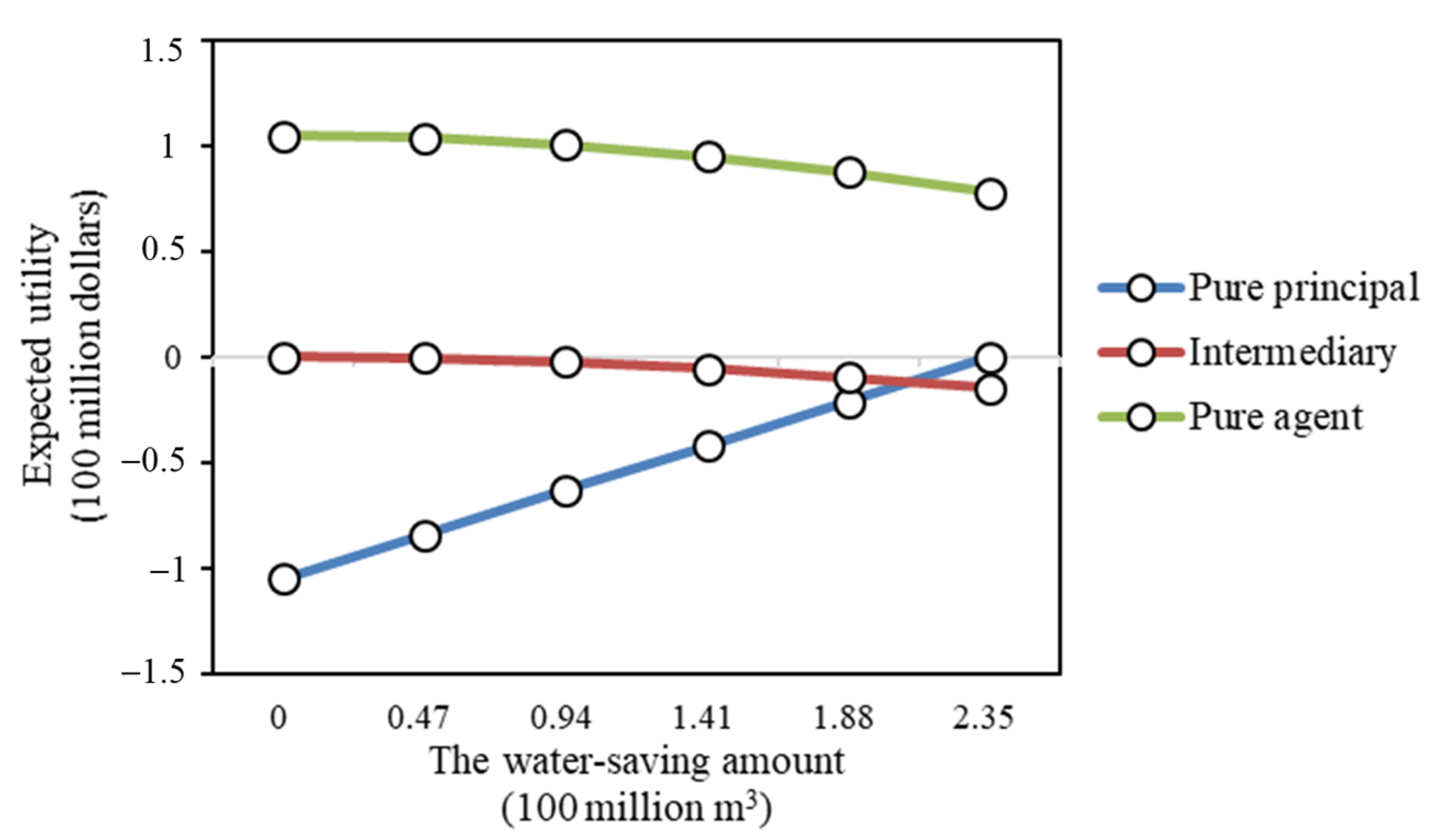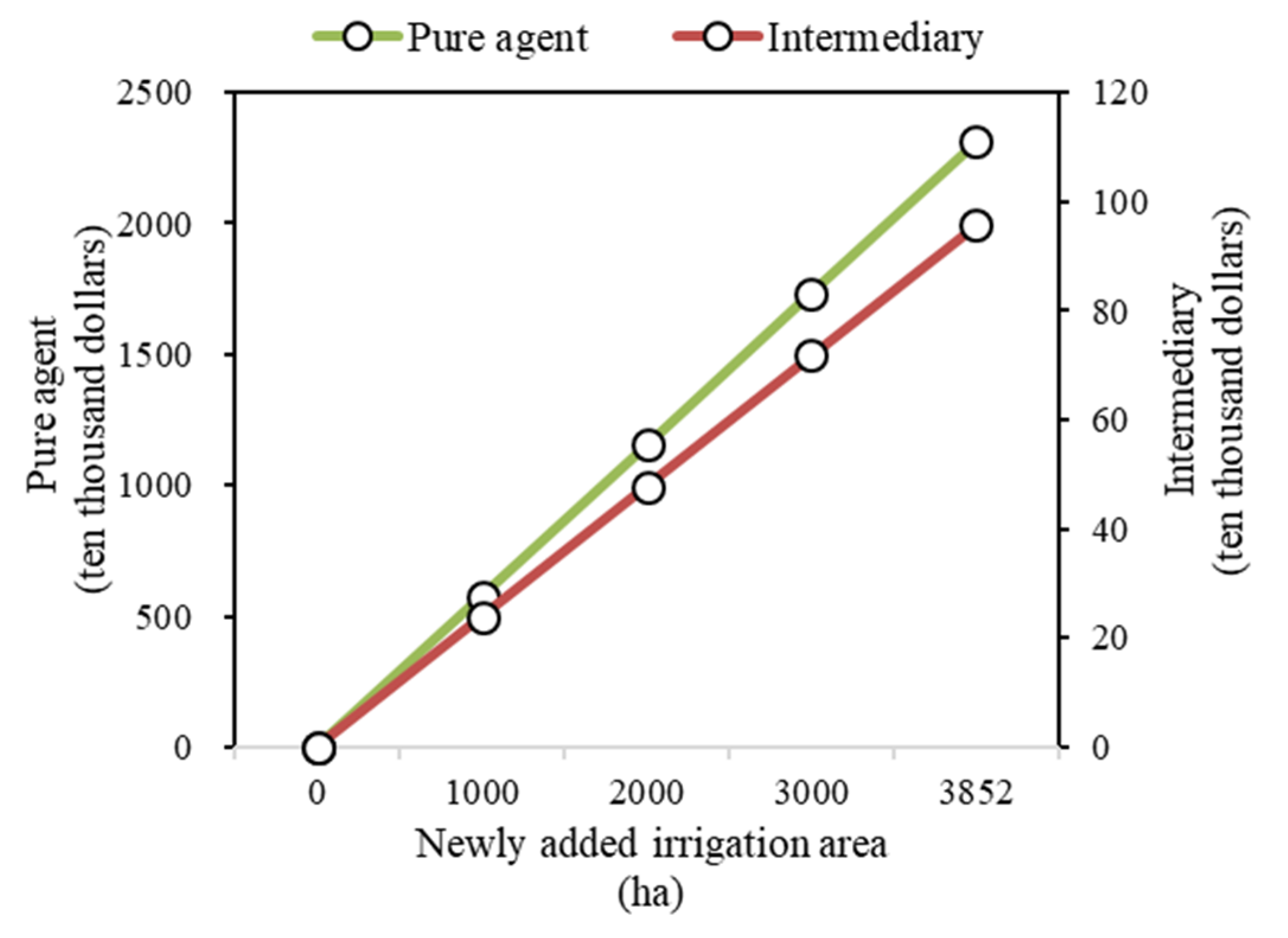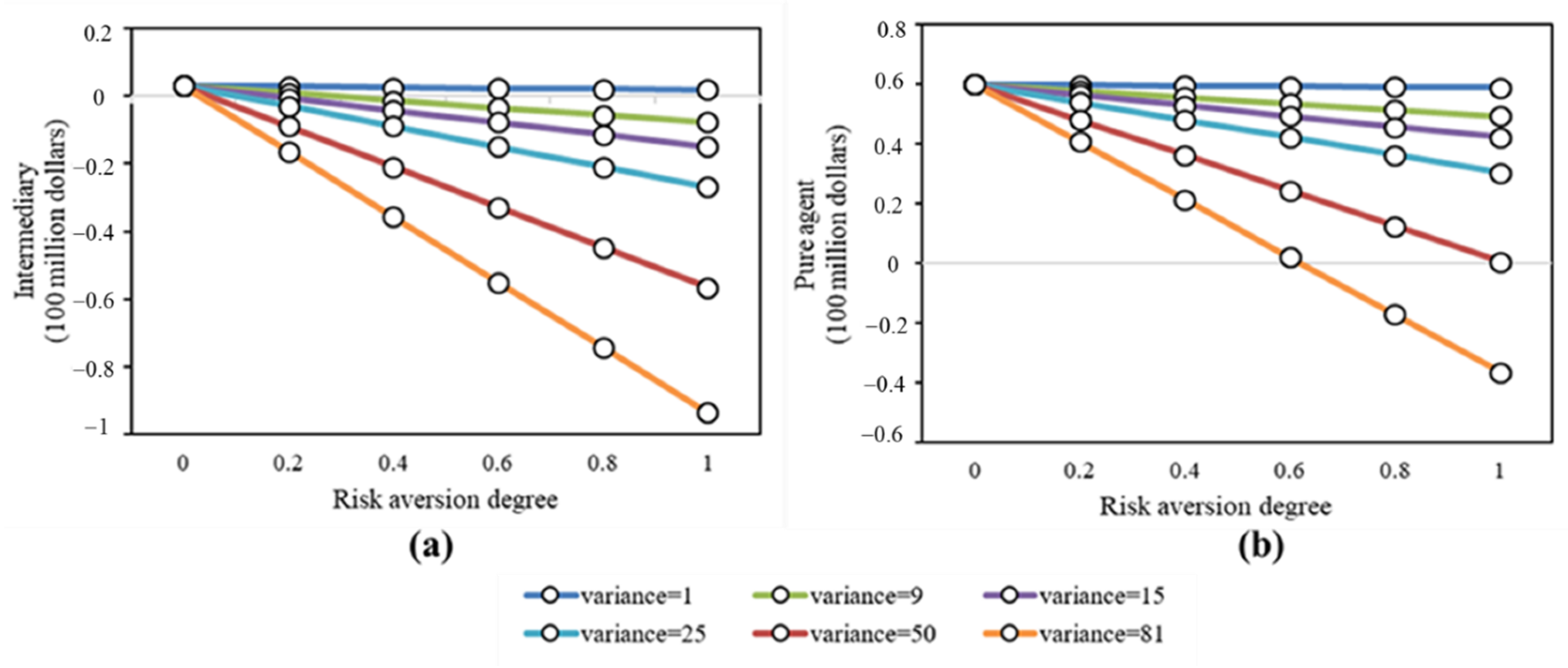1. Introduction
Water is an essential natural resource and strategic economic resource to the national economy and people’s livelihood [
1].
UN World Water Development Report 2017 [
2] revealed that two-thirds of the world’s population live in drylands with varying water shortage degrees.
UN World Water Development Report 2020 [
3] further pointed out that water security and climate change will be a sustained and profound crisis facing the world in the coming decades. In 2014, the FAO (Food and Agriculture Organization of the United Nations) [
4] indicated that water shortage is becoming increasingly severe with global population growth and economic development. Meanwhile, the risks of food, energy, and ecology are also intensified. Systematic recognition of the comprehensive utilization of water resources has attracted widespread attention in academia. In 2018, Grafton et al. [
5] wrote an article in
Science, which revealed that irrigation efficiency improvement did not increase the total amount of available water resources at the basin scale, and the traditional high-efficiency use of water resources may trigger an irrigation efficiency paradox. The irrigation efficiency paradox is even more deadly for arid areas where water resources and ecosystems are fragile, accounting for 41% of the global land area. Simultaneously, the scarcity of water resources will create a vicious circle of competition between humans and ecology, making it more challenging to achieve sustainable development goals for 38% of the world’s population in arid areas [
6,
7].
Meanwhile, climate change has an important impact on arid areas. In 2016, Huang [
8] pointed out in
Nature Climate Change that global arid and semi-arid areas will expand along with accelerated greenhouse gas emissions and account for more than 50% of the global land surface by the end of the 21st century. Among the expansion, three-quarters will occur in developing countries. The induced risks on land, ecology, and society will significantly reduce the sustainable development capacity in these areas. Therefore, it is of great theoretical and practical value to systematically understand water resource utilization, comprehensively improve the governance capacity, and effectively solve the paradox of irrigation efficiency for sustainable development in arid areas.
The paradox of irrigation efficiency refers to a phenomenon that new water use offsets the water-saving effect produced by improving irrigation efficiency. This phenomenon is a hot topic in water resource management, and there have been some research outcomes on this issue. In 2008, Ward and Pulido-Velazquez [
9] investigated the impact of the Upper Rio Grande Basin of North America’s water-saving policies on irrigation water and water-saving effects and found that policies aimed at reducing water use can increase water consumption. In 2013, Pfeiffer and Cynthia [
10] evaluated a drip irrigation system’s effect in western Kansas, USA. It was found that the transition to efficient irrigation technology resulted in changes in crop patterns, which, in turn, increased the extraction of groundwater. In 2014, Scott et al. [
11] analyzed and compared the paradox of irrigation efficiency in three different regions—central Chile, southwestern U.S., and south-central Spain. In the absence of a firm policy to limit irrigation area expansion, efficiency improvement will aggravate the shortage and worsen water resource quality. In 2015, García et al. [
12] analyzed five irrigation districts in Andalusia, southern Spain. Moreover, they found that irrigation technology improvements have transformed farmers’ planting patterns to cash crops that consume more water. In 2017, Perry et al. [
13] summarized the paradox of irrigation efficiency in the Near East and North Africa. It was pointed out that only relying on high-efficiency water-saving technology cannot reduce agricultural irrigation water consumption, but measures such as limiting water distribution should be taken to ensure sustainable water utilization. In 2018, Grafton et al. [
5] wrote an article in
Science, pointing out that improved irrigation efficiency often led to farmers planting water-consuming crops and expanding irrigation areas. However, it may not necessarily increase the total amount of available water resources at the basin scale. Koech and Langat [
14] also pointed out that water savings are being reused to expand irrigation area, resulting in a net increase in the total water consumption at the basin scale. Sear et al. [
15] discussed the Jevons’ paradox caused by the application of efficient irrigation technology.
Previous studies have shown that the rebound effect of irrigation water can effectively represent the degree of the paradox of irrigation efficiency. In 2012, the FAO and European Union warned about the paradox of irrigation efficiency caused by irrigation water’s rebound effect [
16,
17]. In 2015, Berbel et al. [
18] summarized the theoretical basis of the rebound effect of irrigation water and investigated methods to avoid the rebound effect using cases in Spain. Loch and Adamson [
19] evaluated the rebound effect of the current water-efficiency-centric policy in Australia’s Murray–Darling Basin. The policy’s incentive to encourage water-use efficiency paradoxically reduces environmental flow volumes on average. In 2018, Li [
20] emphasized water rights’ role in restraining irrigation water’s rebound effect. Song et al. [
21] analyzed and measured the rebound effect of water-use in China’s agricultural sector and pointed out that having caps on water consumption is an effective means to control the rebound effect. Existing research on the rebound effect of irrigation water mainly focuses on the quantitative evaluation of the paradox of irrigation efficiency. However, there is little research on the formation mechanism and driving mechanism of the paradox.
The principal–agent theory is a classical method to analyze the interactions among multiple stakeholders. In 2009, Zhu and Ma [
22] analyzed the multiple-agency relationships among small shareholders, large shareholders, and a board of directors and studied the conduction effect of large shareholders’ plundering in the relationship between corporate governance and corporate value. In 2013, Li and Huang [
23] investigated a pollution supervision mechanism under a centralized governance model and established a multi-principle–agent pollution supervision game model. In 2014, Green [
24] used a multiple principal–agent theory to analyze an incentive system in the medical industry and put forward improvement suggestions. In 2017, Zhao et al. [
25] established a chain-like multiple principal–agent structure based on the Holmstrom–Milgrom model and reconstructed a chain-like dual principal–agent model considering procedural fairness preferences. It can be seen that the multiple principal–agent theory has been extensively applied to various fields, such as corporate governance, the medical industry, and pollution supervision, but its application in irrigation water-saving is still relatively scarce.
In summary, the paradox of irrigation efficiency is a problematic issue that restricts efficient water use in arid areas and would endanger regional ecological security. Quantitatively characterizing the interactions among heterogeneous stakeholders in this phenomenon is the key to revealing the formation and driving mechanism of the irrigation efficiency paradox. Therefore, a rebound intensity model is constructed in this paper to quantitatively evaluate the degree of irrigation efficiency paradox in the Shenwu Irrigation Area in the Hetao Irrigation District of the Inner Mongolia Autonomous Region, northwest China. The focus is information asymmetry among heterogeneous stakeholders in irrigation water-saving management, and the theory of quasi-public goods is introduced to interpret the complex attributes of irrigation water-saving resources in arid areas. On this basis, a dual principal–agent model is established to deal with the interactions among heterogeneous stakeholders in the paradox. The formation mechanism and driving mechanism of the paradox with asymmetric information are analyzed. An incentive mechanism of irrigation water-saving is designed to meet incentive compatibility constraints. Furthermore, adaptive management countermeasures are put forward to coordinate the conflicts among heterogeneous stakeholders, reduce the degree of irrigation efficiency paradox, and ensure water security and sustainable development in arid areas.
3. Countermeasures of the Paradox of Irrigation Efficiency in the Shenwu Irrigation Area Based on a Dual Principal–Agent Model
There is a principal–agent relationship in agricultural water-saving irrigation [
42]. The classical principal–agent theory is essentially a single principal–agent theory. In the 1930s, Berle and Means [
43] firstly proposed the principal–agent problem based on the separation of corporate ownership and management rights. Since the 1970s, Spence and Zeckhauser [
44] and Ross [
45] proposed a bilateral principal–agent theory with a single principal, single agent, and single task. However, the principal–agent relationship does not exist in a single form in practice. Holmstrom [
46] and Sappington [
47] have studied a multi-agent theory with a single principal, multiple agents, and a single task. On this basis, Bernheim and Whinston [
48] proposed a joint principal–agent theory of multiple principals, a single agent, and a single task. Holmstrom and Milgrom [
49] proposed a single principal, single agent, and multi-task principal–agent analysis method based on the bilateral principal–agent theory. Lafont and Meleu [
50] built a single-principal and two-agent model. Two agents perform supervisory functions on each other; Mohapatra [
51] also studied Chinese enterprises’ incentive designs through the multiple principal–agent theory and analyzed the incentive effect of various incentive methods.
Based on studies of the multiple principal–agent model, this paper combines the characteristics of multi-agent participation in irrigation water-saving and analyzes the dual principal–agent relationship in the process of irrigation water-saving. Furthermore, a dual principal–agent model is constructed to analyze the paradox of irrigation efficiency in the Shenwu Irrigation Area.
3.1. Assumptions and Parameters
3.1.1. Assumptions
Irrigation water-saving refers to the amount of surplus water resources resulting from irrigation water-saving projects, which mainly consists of the evaporation and seepage of water resources in the irrigation system. The saved irrigation water can generally serve three purposes: water rights transactions, groundwater recharge, and irrigation area expansion. The irrigation water-saving used in water rights transactions is considered as a private product [
52]. An accurate water metering will be carried out by local departments or their entrusted institutions of water rights trading managers. However, the amount of irrigation water-saving for groundwater recharge is viewed as quasi-public goods [
53], and it is not easy to measure the amount accurately. Generally, local departments will execute an annual survey within their administrative region, but the irrigation water-saving used for groundwater recharge cannot be directly measured. On the one hand, it is currently only possible to measure the total amount of irrigation water used by the Rural Water Cooperation Organization but not the specific amount by each household. As a result, the irrigation water-saving used to expand the irrigation area is a typical common-pool resource [
54]. Once the water needed for expanding farming can be obtained through irrigation water-saving, the Rural Water Cooperation Organization will choose to be a “free rider” [
55] based on individual rationality, and this would further become a collective rational choice. It would gradually induce a “crowding effect”, which would further squeeze the irrigation water-saving for groundwater recharge and result in “the Tragedy of the Commons”. On the other hand, the Irrigation District Management Unit is a self-supporting institution. Its income mainly consists of project construction management fees paid by the local government and the water resources fees paid by the Rural Water Cooperation Organization. More irrigation water-saving occupied by the Rural Water Cooperation Organization also benefits the Irrigation District Management Unit. Therefore, the Irrigation District Management Unit has the motivation to squeeze irrigation water-saving in collusion with the Rural Water Cooperation Organization. Consequently, with information asymmetry, there are heterogeneous interest preferences among stakeholders involved in the irrigation water-saving project. It leads to conflicts between individual rationality and collective rationality and eventually forms the paradox of irrigation efficiency.
There exist asymmetric information and heterogeneous interest expression among different stakeholders in the process of irrigation water-saving. Due to the lack of irrigation water-saving metering, the Rural Water Cooperation Organization and the Irrigation District Management Unit have the same interest preference. However, it contradicts with the interest of the local government, which leads to conflicts among heterogeneous stakeholders and causes “moral hazard” and “adverse selection”.
Figure 3 presents a dual principal–agent relationship among the three types of stakeholders.
As shown in
Figure 3, the essence of the paradox of irrigation efficiency is the conflict of interests among stakeholders with asymmetric information due to the lack of regulatory capacity to manage efficient water utilization. When heterogeneous stakeholders are involved in the principal–agent process, there is a deviation between participation benefit and expected utility, which would induce moral hazard under the condition of asymmetric information. Therefore, in order to describe the dual principal–agent structure of the irrigation water-saving process in the Shenwu Irrigation Area, the following assumptions are designed.
Assumption 1. The amount of water-saving from implementing a water-saving project in an irrigation area is the sum of intermediary and pure agent . That is to say, the water-saving goal of pure principal can be achieved by the decomposition of principal–agent relationships.
Assumption 2. The amount of water-saving of an agent is not only related to its own effort but is also affected by exogenous random variables, which are uncertain. In this paper, the amount of water-saving is used to indicate the efforts of an agent. It is assumed that the total marginal revenue of water-saving projects increases for every unit of water-saving achieved by an agent. The output function of a pure agent through upgrading planting patterns and improving water resource utilization is formulated as , in which is the amount of water saved by the pure agent. The output function of the intermediary is , in which is the amount of water-saving achieved through engineering and non-engineering measures by the intermediary. is a random variable, representing the exogenous uncertainty factor, and follows a normal distribution of mean value 0 and variance ().
Assumption 3. Principals adopt an incentive mechanism [56]. The incentive function of a pure principal to an intermediary is .
The incentive function of an intermediary to a pure agent is .
Among them,is a fixed incentive portion that would not be affected by an agent’s output. refers to a marginal incentive obtained by an agent’s efforts to save water, and is an incentive coefficient, which reflects the incentive strength of a principal to an agent according to actual output,.
Specifically, is the incentive coefficient of a pure principal to an intermediary, and is the incentive coefficient of an intermediary to a pure agent.
Assumption 4. Principals are risk-neutral, while agents are risk-averse. An agent’s utility function can be expressed as,
in which is the coefficient of absolute risk-aversion [
57]
and is monetary gains. For agent output function in different principal–agent relationships, Taylor Expansion is executed at the water-saving quantity .
Then, the risk premium of a pure agent is .
The risk premium of an intermediary is .
Among them, the variance of the exogenous random variable can represent information asymmetry. Larger indicates more significant information asymmetry, which results in a greater cost of risk but higher expected returns for an agent. In contrast, a principal’s income will decrease along with the increase in .
Assumption 5. An agent’s water-saving cost is a quadratic function of the amount of water-saving [58]. The water-saving cost of an intermediary is .
The water-saving cost of a pure agent is .
is the water-saving cost coefficient of a water-saving project, which indicates an agent’s ability to control water-saving cost. The greater is, the greater the cost of an agent’s effort to achieve is. For the convenience of calculation, in this paper, it is assumed that the water-saving cost coefficient is the same for all agents in the dual principal–agent relationship, and .
3.1.2. Parameters
Key parameters in the dual principal–agent model of the irrigation water-saving process in the Shenwu Irrigation Area are listed in
Table 2.
3.2. Construction of a Dual Principal-Agent Model
A water-saving project in an irrigation district involves three stakeholders: the local government, the Irrigation District Management Unit, and the Rural Water Cooperation Organization. Their interactions are systematic, hierarchical, and dynamic. It is difficult to describe this process with the traditional single-layer principal–agent model. Therefore, a chain-like multiple principal–agent model proposed by Zhao [
25] is adopted. In this paper, a dual principal–agent model (DPAM) for irrigation water-saving management is constructed, considering the principal–agent structure in a water-saving project and the marginal income of the agent’s effort in output function. It also distinguishes the different retention benefits of intermediaries and pure agents within the constraint of individual rationality (
IR). The model describes a chain-like principal–agent relationship among a pure principal (the local government), an intermediary (the Irrigation District Management Unit), and a pure agent (the Rural Water Cooperation Organization) in the process of irrigation water-saving. It is worth pointing out that the Irrigation District Management Unit, as an intermediary, has dual identities, which is the agent in the first principal–agent relationship and the principal in the second principal–agent relationship. According to the assumptions and parameters described in
Section 4.1, the participation benefit function and expected utility function of stakeholders in the principal–agent process are constructed. DPAM is proposed to satisfy incentive compatibility constraints and individual rationality constraints.
3.2.1. Participation Benefit Function
According to the assumptions, stakeholders’ participation benefit is defined as income minus water-saving cost and incentive cost. In the process of irrigation water-saving, the participating benefit function is formulated as follows:
where
is the participation benefit of a pure principal and
is the output function of an intermediary, while the incentive cost of a pure principal to an intermediary is
. An intermediary’s participation benefit is denoted by
, the water-saving cost of an intermediary is
, and the incentive cost of an intermediary to a pure agent is
. A pure agent’s participation benefit is expressed as
If and the water-saving cost of a pure agent is
.
3.2.2. Expected Utility Function
According to the assumptions, if a pure principal is risk-neutral, a pure principal’s expected utility can be expressed as the participation benefit without considering risk cost. According to the certainty equivalence income hypothesis [
59], the expected utility of an intermediary and a pure agent can be expressed as the participation benefit considering the risk premium cost. It is assumed that the expected utility function of stakeholders is first-order continuous and differentiable. Therefore, the expected utility in this paper is defined as the difference between participation benefit and risk premium cost. The expected utility function is formulated as follows:
where the expected utility of a pure principal is
. The expected utility of an intermediary is
and
is the risk premium cost of the intermediary. The expected utility of a pure agent is
and
is the risk premium cost of the pure agent.
3.2.3. A Dual Principal–Agent Model
Based on Formulas (3) and (4) and the characteristics of interactions among stakeholders in the irrigation water-saving process, a DPAM is constructed as follows:
where
IC represents the incentive-compatible constraint of a principal–agent process and
IR stands for the individual rationality constraint of the intermediary and pure agent in the principal–agent process.
and
are the retention benefits of an intermediary and a pure agent, respectively. In this model, the retention benefit is represented by a stakeholder’s income who does not participate in an irrigation water-saving project.
3.3. Model Analysis
Considering
IC and
IR, by solving Formula (5), the Pareto optimal solutions of a pure agent’s water-saving
and an intermediary’s water-saving
are shown as follows:
Then, the Pareto optimal water-saving quantity
under the dual principal–agent condition is:
From Formula (6), it can be seen that the optimal water-savings for a pure agent and an intermediary are directly proportional to the added value of total marginal income, , and incentive coefficient, , but inversely proportional to the water-saving cost coefficient, . By designing a suitable incentive mechanism for heterogeneous stakeholders, improving the total marginal income of water-saving projects, and reducing the water-saving cost coefficient, the amount of water-saving from irrigation water-saving projects can be improved.
Furthermore, according to the optimal water saving
, the optimal expected utilities of a pure principal, an intermediary, and a pure agent can be respectively calculated as follows:
According to IR in Formula (5), a pure principal’s optimal expected utility is inversely proportional to the retention benefit of intermediary and pure agent. The higher the retention benefit is, the higher the expected utility is for the intermediary and the pure agent. In contrast, the expected utility of a pure principal would be less.
On the one hand, the added value of total marginal income and the total water-saving cost coefficient of water-saving projects are output variables, rather than decision-making variables, of multi-stakeholder interactions. On the other hand, the retention benefits of the intermediary and pure agent are historical monetary income, which are decision variables that cannot be optimized. Therefore, the focus in this paper is to analyze the risk decision-making of heterogeneous stakeholders in the process of irrigation water-saving through the dual principal–agent model. It is revealed that information asymmetry provides an objective basis for forming an irrigation efficiency paradox, and the profit motive of a pure agent is an endogenous driving force of the irrigation efficiency paradox. At the same time, the heterogeneity of risk premium among multiple stakeholders is an exogenous driving force.
Theorem 1. In a DPAM, both the pure agent and the intermediary have a positive risk premium. With asymmetric information, these two kinds of stakeholders can benefit from the paradox of irrigation efficiency. Simultaneously, a pure agent has a higher risk premium than an intermediary, and its profit motive is an endogenous driving force of the irrigation efficiency paradox. It is assumed that stakeholders involved in irrigation water-saving projects satisfy the bounded rationality hypothesis [60]. Due to limited water metering, a pure agent’s actual water consumption cannot be accurately known by pure principal and intermediary. Therefore, there exist asymmetric information and unbalanced interests among stakeholders in the DPAM. Moreover, a pure agent bears a greater risk and a higher risk premium than an intermediary. Theorem 2. The risk aversion degree of an agent is inversely related to the incentive coefficient of a principal. Under the situation of asymmetric information, a DPAM may induce a vicious circle and further induce agents to squeeze the saved water. The heterogeneity of risk premium among stakeholders is an exogenous driving force of the irrigation efficiency paradox. In a DPAM, on the one hand, by increasing the incentive coefficient, a principal can reduce the risk aversion degree of an agent and encourage the agent to improve its effort. On the other hand, with a higher risk aversion degree for an agent, the incentive effect of improving the agent’s incentive coefficient would be less. Therefore, a principal may choose to reduce the incentive coefficient, which leads to a vicious circle.
5. Analysis and Discussion
This section will further discuss the information asymmetry and risk heterogeneity of stakeholders in the irrigation efficiency paradox and clarify the conflict of objectives among stakeholders behind the irrigation efficiency paradox.
Firstly, the implementation of an irrigation water-saving project has heterogeneous impacts on the expected utility of stakeholders. A pure principal’s expected utility increases steadily along with the water-saving amount, but the expected utility of an intermediary and a pure agent shows a downward trend, which shows a significant heterogeneity with the pure principal. Combined with information asymmetry caused by inadequate water metering, the pure agent and the intermediary will undoubtedly pursue maximum individual income by increasing water-saving occupation. Thus, total water saving is reduced, which leads to the paradox of irrigation efficiency. Theorem 1 proved that the intermediary and the pure agent have information superiority and their profit motive is an endogenous driving force of the irrigation efficiency paradox. Therefore, in the process of agricultural water-saving, the interests of the Rural Water Cooperation Organization and the Irrigation District Management Unit should be taken into account. By reasonably designing a water-saving benefit-sharing mechanism, incentive benefits can be provided to the Rural Water Cooperation Organization and the Irrigation District Management Unit, therefore the intensity of irrigation efficiency paradox can be reduced.
Secondly, a pure agent’s action of irrigation area expansion is mainly because irrigation water-saving projects provide extra water that is considered quasi-public goods and the land cost of expansion is minimal. Therefore, when water metering is not in place, a pure agent can take advantage of the information and utilize water-saving for agricultural production to obtain extra utility. An irrigation water-saving project significantly reduces the total amount of irrigation water consumption by reducing water seepage, leading to a decrease in water fee income for an intermediary. Although the construction and management of a water-saving project provide benefit compensation to the intermediary, when the benefits compensation is lower than the water fee loss, the intermediary’s total income will be damaged. Simultaneously, inadequate agricultural water metering also makes it difficult to monitor the actual water consumption. Because the income of an intermediary increases along with the increase in total agricultural irrigation water consumption, the intermediary also has the motivation to allow a pure agent to increase its irrigation water under information asymmetry. Therefore, in addition to provide a water-saving incentive income, it is also essential to increase investment in irrigation water metering equipment. It is suggested to take advantage of market entities’ capital and information to promote water-saving management contracts and cooperative management of water-metering equipment. By improving the level of irrigation water metering and reducing information asymmetry, one can mitigate the paradox of irrigation efficiency.
Finally, the degree of risk aversion and the variance of exogenous random variables reflect stakeholders’ risk preference. The expected utilities of an intermediary and a pure agent would decrease along with the increase in risk aversion and the variance of exogenous random variables. Therefore, in the process of irrigation water saving, the action of increasing irrigation water possesses the characteristics of high income and high risk. Under the condition of asymmetric information, when some of the pure agents use regulatory loopholes to expand the irrigation area and produce expected utility, more pure agents will join the group if there is no reasonable and adequate supervision. It will lead to a large-scale expansion and occupation of expected water-saving, thus further aggravating the paradox of irrigation efficiency. Therefore, it is vital to specify rules on using irrigation water-saving, enhance the total amount and water monitoring for sand control and irrigation area expansion, and design a binding mechanism for water-saving usage.
6. Conclusions
To deal with the irrigation efficiency paradox, a rebound intensity model and a dual principal–agent model were constructed based on the rebound effect of irrigation water and principal-agent theory. The models were applied to the Shenwu Irrigation Area as a case study. The results show that there is a paradox of irrigation efficiency caused by a disorderly expansion of irrigation area in the Shenwu Irrigation Area. As a water rights trade pilot in arid areas, many water-saving projects have been implemented in the Shenwu Irrigation Area. However, due to unauthorized expansion of irrigation area by the Rural Water Cooperation Organization, a huge amount of water-saving is not returned to the ecology as planned. As a result, the expected effect of water-saving projects has faded.
Along with an aggravated over-extraction of groundwater, great harm has been caused to the local ecological environment. The essence of the paradox of irrigation efficiency lies in the conflict of objectives among heterogeneous stakeholders under asymmetric information and inadequate supervision. The Rural Water Cooperation Organization prefers to expand the irrigation area, which is cost-effective and gains profit fast. The Irrigation District Management Unit tends to sell more water to increase its income. According to their interest preference, their behavior contradicts the local government’s water-saving plan, which results in the paradox of irrigation efficiency. The analysis and discussion of the dual principal–agent model propose several countermeasures to reduce the intensity of the paradox of irrigation efficiency: take into account the interests of various stakeholders and formulate a reasonable benefit-sharing mechanism; improve the level of irrigation water metering and reduce information asymmetry; specify the regulation of water-saving and enhance the management and restriction of water use.
